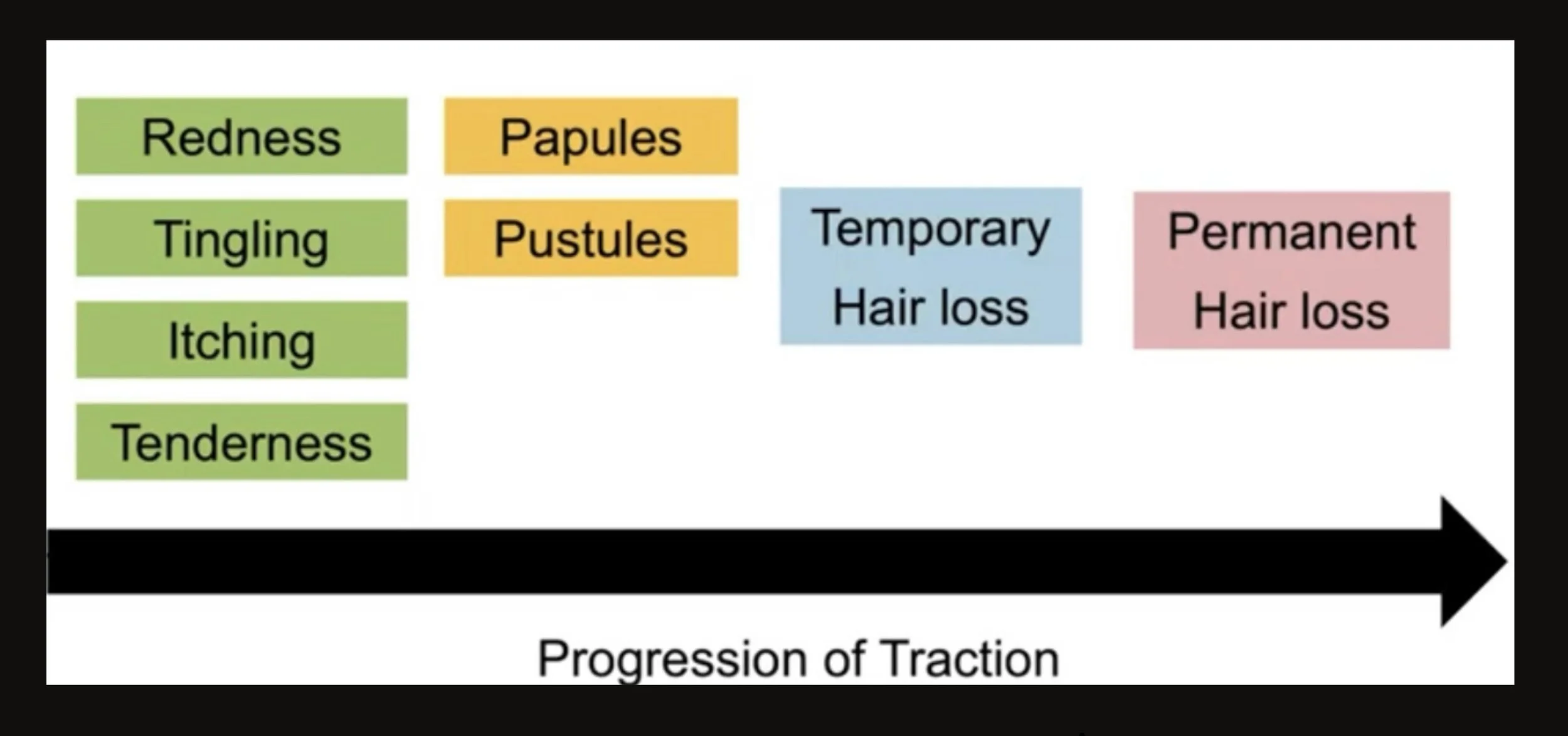Helping Patients Reduce the Chance of Traction Alopecia
Traction Alopecia is Reversible - But Only in the early Stages
Traction alopecia is a form of hair loss whereby pulling forces on the hair cause hair loss. Patients with traction alopecia often develop redness around the hairs (perifollicular erythema) and tingling, itching or tenderness and headaches in the earliest stages followed by papules and pustules as the pulling continues. Khumalo showed in 2008 that 81.1% of patients with traction alopecia TA had a history of symptoms during hairdressing. Traction forces applied to hair can progress to temporary hair loss and finally permanent hair loss if the forces are applied for enough time.
Not All Patients with Traction Alopecia Regrow Hair
If traction alopecia is immediately recognized and the pulling forces stopped, hair can recover and permanent hair loss becomes less likely. However, if the traumatic hairstyling is not stopped, inflammation in the scalp facilitates the development of fibrosis (scar tissue) within the dermis and permanent destruction of hairs.
Traction alopecia can occur in many different racial backgrounds. Black patients are at high risk due and it has been estimated that one third of black women experience traction alopecia.
Traction alopecia can happen anywhere on the scalp. TA affecting black patients may be categorized into three main subtypes: anterior hairline, ophiasis pattern, and patchy. It often occurs in the frontal scalp but it can occur in other areas where pulling of hairs is occurring. Glued and sewn in weaves increase the risk for a variety of patterns affecting the back of the scalp.
The Importance of Early Intervention in Traction Alopecia
Traction alopecia is an important issue in both pediatric patients and adults. The early intervention is key and this really comes from early recognition. As practitioners, we need to be comfortable advising patients about traction in a respectful manner. Preventing hair loss in our patient must be placed at the center of all discussion. It’s not so much a discussion with parents that hairstyles need to be completely stopped but rather modified to reduce the risk of traction. Completely stopping certain practices may be viewed as unrealistic, impractical and lead to loss of trust between patient and the provider if it comes to be felt that providers don’t understand the importance of certain practices. One must never shame patients. Patients can be encouraged to avoid tight pulling of hair and to take breaks every few weeks to let hair down.
Hairstyles are important so it’s not so much a discussion about what hairstyles to use or not to use but rather an understanding of the possibility of permanent hair loss if traction does occur. Headaches, tingling, redness, bumps and pustules are all signs that traction alopecia could be present. As mentioned, Khumalo et al showed in 2008 that 81.1% of patients with traction alopecia TA had a history of symptoms during hairdressing. Pain that occurs after hairstyling is one of the earliest symptoms of traction alopecia and must be given a lot of attention. It does not occur in all patients with traction but it is extremely important to take note of. Some patients have come to learn that these symptoms are just a “normal” expected part of having certain hairstyles. Education is therefore needed to clarify these types of long held views. Symptoms are the body’s way of saying that the hairstyle is too tight. Khumalo et al also showed that patients with tight painful braids or pimples developing at the base of hairs have a nearly two fold increased risk of traction.
Traction alopecia can occur in children and adults of all racial and ethnic backgrounds. However, the risks are increased in black patients with tight curl patterns. We know that the risks of traction are even further increased if traction hairstyles are applied to thermally or chemically relaxed hair. This seems to compound the risk.
REFERENCE
Khumalo NP et al. Determinants of marginal traction alopecia in African girls and women. J Am Acad Dermatol. 2008;59:432-438.
This article was written by Dr. Jeff Donovan, a Canadian and US board certified dermatologist specializing exclusively in hair loss.

